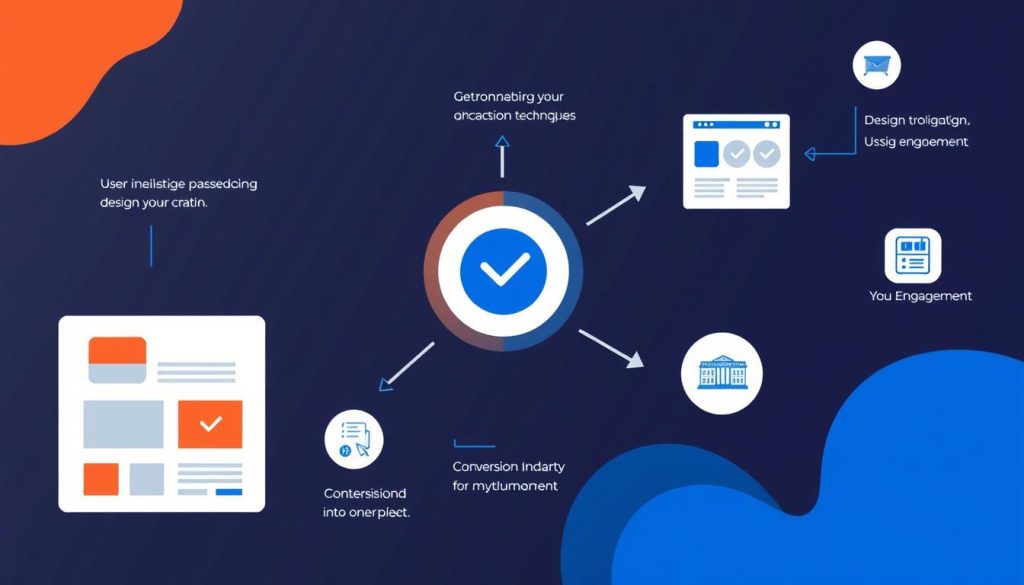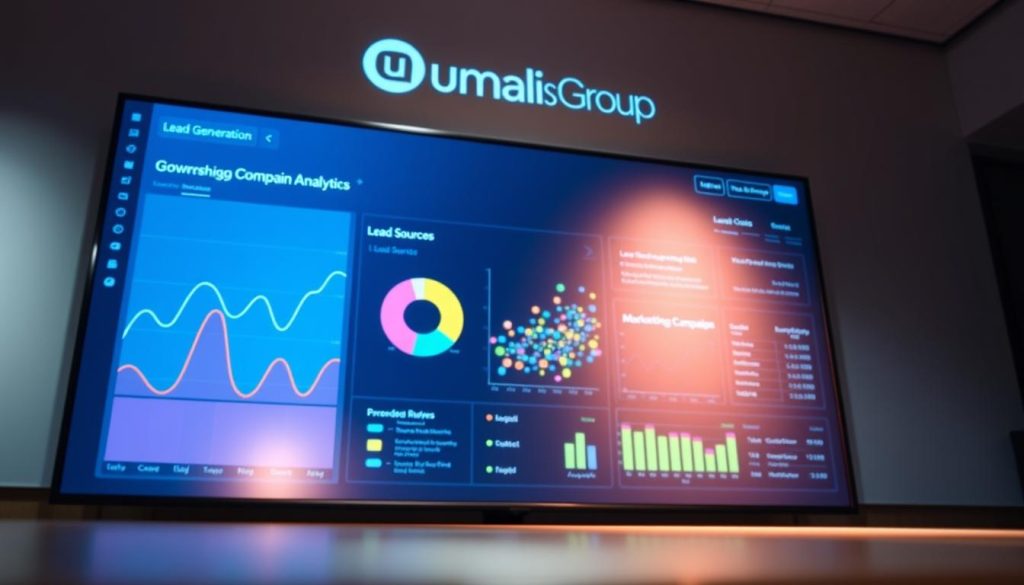Navigating a career transition can be a daunting task, especially in today’s competitive market. As an independent professional, you need a steady stream of opportunities to ensure stability and security. Effective lead generation is crucial for achieving this goal.
With 85% of B2B professionals considering lead generation their most important marketing objective, it’s clear that this skill is essential for career success. By understanding and implementing proven lead generation techniques, you can build a sustainable system that supports your long-term career goals.
Table of Contents
Key Takeaways
- Understand the fundamentals of lead generation for career transition
- Implement targeted marketing strategies to attract prospects
- Leverage automation tools to optimize your lead generation process
- Build a sustainable system for long-term career success
- Enhance your career stability with effective lead generation techniques
Understanding Lead Generation for Career Professionals
Lead generation is a crucial aspect of career development, especially during professional transitions. As career professionals navigate changes in their industry, they must adapt their strategies to stay ahead.
What is Lead Generation in a Career Context?
Lead generation refers to the process of identifying and cultivating potential clients or opportunities. In a career context, it involves creating a pipeline of prospects who may be interested in your services or expertise. Effective lead generation allows professionals to build a consistent flow of opportunities, reducing dependence on traditional job markets.
The Importance of Lead Generation During Career Transitions
During career transitions, lead generation provides crucial stability by creating a consistent pipeline of opportunities. The benefits of lead generation include:
- Reducing dependency on traditional job markets, giving professionals greater control over their trajectory and income potential.
- Building valuable professional relationships that can evolve into long-term clients, referral sources, or strategic partnerships.
- Testing market demand for services before fully committing to a new career direction, minimizing risk during transitions.
- Creating momentum that can carry professionals through the challenging initial phases of establishing themselves in a new capacity.
- Gaining valuable insights about the target market, helping professionals refine their offerings to better meet client needs.
- Implementing a cost-effective marketing stratégie that generates 62% less costs than other classic techniques, according to a Hubspot survey.
By focusing on lead generation early in their career transition, professionals can create a robust foundation for long-term success. This proactive approach enables them to capitalize on emerging opportunities and navigate the challenges of their new career path with confidence.
The Lead Generation Process for Independent Professionals
For independent professionals, mastering the lead generation process is crucial for a successful career transition. This process involves a strategic approach to identifying potential clients and guiding them through the sales funnel.
Identifying Your Target Audience
Understanding your target audience is the first step in the lead generation process. It involves researching their needs, challenges, and behaviors to create targeted marketing campaigns. By identifying your ideal client, you can tailor your services and messaging to resonate with them, increasing the likelihood of conversion.
Creating Your Professional Value Proposition
Your professional value proposition (PVP) is a statement that defines the unique benefits you offer to clients. It’s essential to craft a compelling PVP that differentiates you from competitors and addresses the specific needs of your target audience. A strong PVP is key to attracting high-quality leads.
Building a Lead Generation Funnel
A lead generation funnel is a structured process that guides potential clients from initial awareness to becoming paying customers. The funnel is divided into three main stages:
- Attracting visitors through valuable content
- Nurturing leads with specific information
- Converting leads into clients through personalized communication
To illustrate the effectiveness of a lead generation funnel, consider the following table that outlines the stages and corresponding strategies:
| Stage | Strategy | Goal |
|---|---|---|
| Attract | Valuable content creation | Increase website visitors |
| Nurture | Email marketing campaigns | Build lead relationships |
| Convert | Personalized communication | Turn leads into clients |
By understanding and implementing these stages, independent professionals can create an effective lead generation process that drives business growth. The key is to track metrics at each stage to identify areas for optimization and improve overall lead generation effectiveness.
Essential Lead Generation Strategies for Career Transition

To navigate career transitions smoothly, professionals must employ effective lead generation techniques. Lead generation is a critical process that involves identifying and cultivating potential clients or opportunities. For professionals transitioning to new career paths, having a robust lead generation strategy in place is vital for securing new opportunities and achieving success.
Content Marketing for Professional Visibility
Content marketing is a powerful tool for professionals looking to increase their visibility and attract potential clients. By creating high-quality, relevant content, professionals can establish themselves as experts in their field and attract leads. This can be achieved through various formats such as blog posts, articles, and whitepapers. For more insights on finding clients online, you can visit this resource for valuable tips.
Social Media Lead Generation Techniques
Social media platforms offer a vast array of opportunities for lead generation. Professionals can leverage platforms like LinkedIn to connect with potential clients and promote their services. Effective social media strategies include creating engaging content, participating in relevant discussions, and utilizing paid advertising options. By building a strong online presence, professionals can increase their chances of generating high-quality leads.
Email Marketing Campaigns
Email marketing remains one of the most effective lead generation channels for professionals. It offers direct communication with potential clients at a fraction of the cost of other methods. Building a quality email list and segmenting it based on professional interests or engagement levels allows for targeted messaging. Automated email sequences can nurture leads through the decision-making process, providing relevant information at the right time. Personalization based on recipient data and behavior significantly improves email engagement rates, with personalized emails delivering six times higher transaction rates.
By implementing these lead generation strategies, professionals can enhance their career transition journey. It’s essential to maintain a marketing relationship with potential clients to guide them towards conversion. This involves interacting with prospects throughout the purchasing decision process, making them more mature and prepared for a purchase. With the right approach, professionals can achieve their career goals and secure new opportunities.
Leveraging Digital Platforms for Lead Generation

The rise of new advertising platforms has opened up fresh opportunities for generating leads and expanding market share. To capitalize on this trend, professionals must identify and leverage the most effective digital platforms for their specific needs.
LinkedIn Optimization for Professional Lead Generation
LinkedIn is a powerful tool for professionals looking to generate leads. By optimizing your LinkedIn profile, you can increase your visibility and attract potential clients. This involves creating a compelling headline, using relevant keywords, and engaging with your network through meaningful content.
Personal Website and Portfolio Development
A professional website and portfolio are essential for showcasing your expertise and services. By developing a robust online presence, you can attract potential leads and establish credibility in your field. Ensure that your website is user-friendly, mobile-responsive, and contains clear calls-to-action.
Industry-Specific Platforms and Communities
Industry-specific platforms and communities offer targeted lead generation opportunities. By participating in these niche networks, you can connect with professionals who understand the value of your expertise. This can lead to valuable connections, partnerships, and pre-qualified leads. For instance, you can develop your client base in portage by leveraging these platforms effectively.
Some key benefits of using industry-specific platforms include:
- Targeted lead generation opportunities
- Positioning yourself as an insider with relevant knowledge and connections
- Creating organic lead generation opportunities through relationship development
- Showcasing your services to a highly relevant audience
- Building referral partnerships with complementary service providers
By focusing on the right digital platforms and optimizing your presence, you can significantly enhance your lead generation efforts and achieve your business goals.
Creating High-Converting Lead Magnets

For independent professionals seeking to establish a strong market presence, developing compelling lead magnets is essential. Lead magnets are resources or tools offered to potential clients in exchange for their contact information, typically an email address. They serve as a crucial element in building a lead generation stratégie that drives business growth.
Types of Lead Magnets for Career Professionals
Career professionals can utilize various types of lead magnets to attract potential clients. These include e-books, whitepapers, webinars, and checklists that address specific pain points or interests of their target audience. The key is to create content that is both informative and relevant, showcasing your expertise and providing value to your prospects.
Designing Lead Magnets That Convert
To design lead magnets that convert, focus on creating high-quality, engaging content. Use compelling headlines and ensure that the content is well-structured and easy to consume. Additionally, incorporating visual elements such as infographics can enhance the appeal of your lead magnet. It’s also crucial to optimize your lead magnet for various devices, ensuring that it’s accessible to a broad audience.
Distribution Strategies for Maximum Exposure
Strategic distribution across multiple channels maximizes the exposure of your lead magnets to your target audience of potential clients. Your website should feature lead magnets prominently on high-traffic pages and within relevant blog content. For instance, you can promote your lead magnets through email campaigns to your existing network, as well as through social media promotion, including both organic posts and targeted paid advertising. For more insights on transitioning your career, you can refer to our comprehensive guide on moving from job demand to service.
Other effective strategies include guest posting on industry publications and partnering with complementary service providers for cross-promotion. By leveraging these channels, you can significantly enhance the visibility of your lead magnets and attract more leads.
Building Effective Landing Pages for Lead Capture

To maximize lead capture, it’s crucial to build effective landing pages that convert visitors into leads. A well-designed landing page can significantly improve the success of a lead generation campaign.
Essential Elements of High-Converting Landing Pages
High-converting landing pages share certain essential elements that contribute to their success. These include a clear and compelling headline, a concise and relevant message, and a prominent call-to-action (CTA). The page should also be visually appealing, with a clean design and minimal distractions.
Form Optimization for Higher Conversion Rates
Forms are a critical component of landing pages, as they enable visitors to provide their contact information. To optimize forms for higher conversion rates, keep them short and simple, asking only for essential information. Use clear and concise labels, and ensure that the form is easily accessible on both desktop and mobile devices.
A/B Testing Your Landing Pages
A/B testing is a powerful technique for optimizing landing pages. By systematically comparing different versions of your landing pages, you can identify which elements most effectively convert visitors into leads. Test one variable at a time, such as headline, imagery, or form length, to gain clear insights into what works best.
Some key strategies for A/B testing include:
- A/B testing systematically compares different versions of your landing pages to identify which elements most effectively convert visitors into leads.
- Testing one variable at a time provides clear data on which specific changes impact conversion rates.
- Prioritize testing elements with the greatest potential impact, typically starting with headlines, calls-to-action, and form configurations.
- Ensure statistical significance by running tests with sufficient traffic volume and duration before drawing conclusions about performance differences.
- Implement a continuous testing program rather than one-time experiments, creating an ongoing optimization process that steadily improves conversion rates.
- Document testing results and insights to build institutional knowledge about what resonates with your specific audience of potential clients.
By following these strategies and continually optimizing your landing pages, you can improve the effectiveness of your lead generation campaign and drive more conversions.
Lead Qualification and Nurturing Techniques
To maximize the potential of lead generation, it’s essential to implement robust qualification and nurturing techniques. This involves a strategic approach to identifying high-quality leads and guiding them through the sales funnel.
Scoring and Qualifying Professional Leads
Lead scoring is a critical component of lead qualification. By assigning scores based on factors such as engagement, demographics, and behavior, professionals can identify the most promising leads. Effective lead scoring enables you to prioritize efforts on high-potential prospects, thereby optimizing resource allocation.
A well-structured lead scoring system considers various data points, including:
- Job title and industry
- Company size and revenue
- Engagement with content and website
- Previous interactions and purchases
Developing Nurturing Sequences
Nurturing sequences are designed to build relationships with leads by providing value and relevance. By leveraging marketing automation, professionals can create personalized nurturing campaigns that adapt to the maturity of each prospect.
To be effective, lead nurturing must:
| Criteria | Description |
|---|---|
| Quality Content | Offer high-value content that addresses the needs and challenges of leads. |
| Marketing Automation | Utilize automation tools to streamline and personalize the nurturing process. |
| Regular Engagement | Maintain consistent communication to keep leads engaged. |
| Adaptability | Adjust nurturing sequences based on the maturity and behavior of leads. |
Personalization Strategies for Higher Engagement
Personalization is key to transforming generic lead nurturing into meaningful conversations. By leveraging data collected through forms, website behavior, and previous interactions, professionals can tailor communications to individual interests and needs.
« Personalization is not just about addressing leads by their names; it’s about creating relevant experiences that resonate with their specific situations and challenges. »
Effective personalization strategies include:
- Dynamic content that adapts based on lead characteristics or behaviors
- Personalized case studies or success stories that match the lead’s industry or situation
- Segmenting leads based on profession, industry, company size, or specific challenges
Automation Tools for Efficient Lead Generation

Automation tools play a pivotal role in enhancing lead generation for independent professionals. By leveraging these tools, career professionals can streamline their processes, saving time and increasing efficiency.
CRM Systems for Lead Management
CRM (Customer Relationship Management) systems are essential for managing leads. They help organize and analyze data, enabling professionals to make informed decisions. A robust CRM system ensures that no lead is lost and that follow-ups are timely.
Email Automation Platforms
Email automation platforms allow professionals to send targeted campaigns, nurturing leads through the sales funnel. These platforms enable personalization at scale, improving engagement and conversion rates.
Social Media Management Tools
Social media management tools are vital for maintaining a consistent presence across multiple social media platforms. They offer features like scheduling, content curation, and analytics, which are crucial for lead generation. By utilizing these tools, professionals can enhance their brand visibility and engage with their audience more effectively.
The use of automation tools in lead generation not only streamlines processes but also enhances the ability to track and analyze leads. This results in more effective lead generation strategies, ultimately driving career success.
Measuring Lead Generation Success

Understanding the impact of lead generation efforts is vital for making informed decisions. To determine the effectiveness of lead generation campaigns, professionals must track key metrics and analyze the data to identify areas for improvement.
Key Performance Indicators for Lead Generation
To measure lead generation success, career professionals should focus on key performance indicators (KPIs) such as conversion rates, lead quality, and the number of leads generated. These metrics provide insights into the effectiveness of lead generation strategies and help identify areas for improvement.
- Conversion rates indicate the percentage of leads that become clients or take a desired action.
- Lead quality assesses the relevance and potential of generated leads.
- The number of leads generated measures the overall volume of leads produced by the campaign.
Analytics Tools and Reporting
Analytics tools play a crucial role in transforming raw lead data into actionable insights. By leveraging tools like Google Analytics, CRM reporting features, email analytics, and social media analytics, professionals can gain a comprehensive understanding of their lead generation performance.
- Google Analytics provides foundational information about website visitor behavior.
- CRM reporting features track lead progression through the sales funnel.
- Email analytics reveal which messages and content types generate the highest engagement.
- Social media analytics tools measure the lead generation impact of content and engagement strategies.
By creating customized dashboards that combine metrics from multiple sources, professionals can gain a comprehensive view of their lead generation performance at a glance.
Conclusion: Building a Sustainable Lead Generation System for Long-Term Career Success
As you navigate your career transition, building a robust lead generation system is crucial for long-term success. This involves creating a sustainable process that evolves with your professional development and market conditions.
A successful lead generation strategy combines multiple complementary approaches, creating resilience against market changes. Consistency in execution is key; implementing a simple system consistently yields better results than an elaborate approach applied sporadically.
Your lead generation strategy should adapt as your career progresses, with different techniques becoming more relevant as you establish yourself. Automation should be implemented strategically to handle repetitive tasks while preserving the personal touch that distinguishes professional service relationships.
Regular review and refinement based on performance data will ensure your lead generation system continues to improve in efficiency and effectiveness. The ultimate goal is to create a self-sustaining ecosystem that consistently delivers qualified leads with decreasing effort, providing security and stability throughout your career.
FAQ
What is the primary goal of lead generation for independent professionals?
The primary goal is to identify and attract potential clients, creating opportunities for career advancement and business growth.
How can I optimize my LinkedIn profile for lead generation?
To optimize your LinkedIn profile, ensure your headline and summary clearly state your professional value proposition, and engage with your network through relevant content and discussions.
What types of content are most effective for lead generation?
High-quality, relevant, and informative content such as blog posts, e-books, and webinars can be effective for attracting potential clients and establishing your expertise.
How do I qualify leads for my business?
Qualifying leads involves assessing their potential value based on factors such as their needs, budget, and decision-making authority, allowing you to focus on the most promising opportunities.
What are some key performance indicators (KPIs) for measuring lead generation success?
Important KPIs include conversion rates, lead volume, cost per lead, and return on investment (ROI), which help you evaluate the effectiveness of your lead generation strategies.
How can automation tools enhance my lead generation efforts?
Automation tools such as CRM systems, email automation platforms, and social media management tools can streamline your lead generation process, improve efficiency, and enable personalized engagement with potential clients.
What is the role of a lead magnet in lead generation?
A lead magnet is a valuable resource offered in exchange for contact information, helping to capture potential clients and initiate a nurturing process.
How can I create a high-converting landing page?
To create a high-converting landing page, focus on a clear and compelling headline, concise and relevant content, and a prominent call-to-action, while also optimizing forms and testing different elements.





